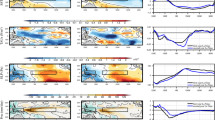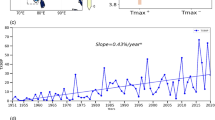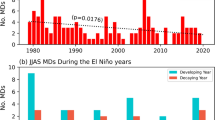Abstract
Extremely anomalous features of Meiyu in 2020 over the Yangtze-Huai River basin (YHRB) and associated causes in perspective of the large-scale circulation are investigated in this study, based on the Meiyu operational monitoring information and daily data of precipitation, global atmospheric reanalysis, and sea surface temperature (SST). The main results are as follows. (1) The 2020 YHRB Meiyu exhibits extremely anomalous characteristics, which are the most prominent since the 1980s. The 2020 Meiyu season features the fourth earliest onset, the third latest retreat, the longest duration, the maximum Meiyu rainfall, the strongest mean rainfall intensity, and the maximum number of stations/days with rainstorm. (2) The extremely long duration of the 2020 Meiyu season lies in the farily early onset and late retreat of Meiyu in this particular year. The early onset of Meiyu is due to the earlier-than-normal first northward shift and migration of the key influential systems including the northwestern Pacific subtropical high (NWPSH) and the South Asian high (SAH) along with the East Asian summer monsoon, induced by weak cold air activities from late May to early mid-June. However, the extremely late retreat of Meiyu is because of later-than-normal second northward shift of the associated large-scale circulation systems accompanied with strong cold air activities, and extremely weak and southward located ITCZ over Northwest Pacific in July. (3) The extremely more than normal Meiyu rainfall is represented by its long duration and strong rainfall intensity. The latter is likely attributed to extreme anomalies of water vapor convergence and vertical ascending motion over the YHRB, resulting from the compound effects of the westward extended and enlarged NWPSH, the eastward extended and expanded SAH, and the strong water vapor transport associated with the low-level southerly wind. The extremely warm SST in the tropical Indian Ocean seems to be the key factor to induce the above-mentioned anomalous large-scale circulations. The results from this study serve to improve understanding of formation mechanisms of the extreme Meiyu in China and may help forecasters to extract useful large-scale circulation features from numerical model products to improve medium-extended-range operational forecasts.
Similar content being viewed by others
References
Bi, B. G., M. Y. Jiao, and Z. C. Li, 2004: Contrast analysis of meteorological and hydrological features of extremely heavy rainfall causing severe floods in Huaihe River valley. J. Nanjing Inst. Meteor., 27, 577–586, doi: https://doi.org/10.3969/j.issn.1674-7097.2004.05.001. (in Chinese)
Chen, L. J., W. Gu, Z. S. Gong, et al., 2019: Precursory signals of the 2018 summer climate in China and evaluation of real-time prediction. Meteor. Mon., 45, 553–564. (in Chinese)
Dai, T. L., Q. L. Wang, G. F. Wang, et al., 2021: Climatic characteristics and major meteorological events over China in 2020. Meteor. Mon., 47, 478–487, doi: https://doi.org/10.7519/j.issn.1000-0526.2021.04.009. (in Chinese)
Ding, T., R. Q. Han, and H. Gao, 2020: Overview of climate prediction for the summer 2019 and the precursory signals. Meteor. Mon., 46, 556–565, doi: https://doi.org/10.7519/j.issn.1000-0526.2020.04.010. (in Chinese)
Ding, Y. H., Y. Y. Liu, and Z. Z. Hu, 2021: The record-breaking Meiyu in 2020 and associated atmospheric circulation and tropical SST anomalies. Adv. Atmos. Sci., doi: https://doi.org/10.1007/s00376-021-0361-2.
Gao, H., and F. Xue, 2006: Seasonal variation of the cross-equatorial flows and their influences on the onset of South China Sea summer monsoon. Climatic Environ. Res., 11, 57–68, doi: https://doi.org/10.3878/j.issn.1006-9585.2006.01.05. (in Chinese)
General Administration of Quality Supervision, Inspection, and Quarantine of the People’s Republic of China, 2017: GB/T 33671-2017 Meiyu Monitoring Indices. Standards Press of China, Beijing, 15 pp.
Gill, A. E., 1980: Some simple solutions for heat-induced tropical circulation. Quart. J. Roy. Meteor. Soc., 106, 447–462, doi: https://doi.org/10.1002/qj.49710644905.
Jiang, W., and H. Gao, 2013: New features of Meiyu over middle-lower reaches of Yangtze River in the 21st century and the possible causes. Meteor. Mon., 39, 1139–1144. (in Chinese)
Jiang, Z. H., Y. C. Shen, T. T. Ma, et al., 2014: Changes of precipitation intensity spectra in different regions of mainland China during 1961–2006. J. Meteor. Res., 28, 1085–1098, doi: https://doi.org/10.1007/s13351-014-3233-1.
Kanamitsu, M., W. Ebisuzaki, J. Woollen, et al., 2002: NCEP-DOE AMIP-II Reanalysis (R-2). Bull. Amer. Meteor. Soc., 83, 1631–1644, doi: https://doi.org/10.1175/bams-83-11-1631.
Li, C., and S. L. Li, 2014: Interannual seesaw between the Somali and the Australian cross-equatorial flows and its connection to the East Asian summer monsoon. J. Climate, 27, 3966–3981, doi: https://doi.org/10.1175/jcli-d-13-00288.1.
Li, D. L., P. C. Shao, H. Wang, et al., 2013: Advances in research of the north boundary belt of East Asia subtropical summer monsoon in China. Plateau Meteor., 32, 305–314. (in Chinese)
Li, L., C. W. Zhu, R. H. Zhang, et al., 2021: Roles of the Tibetan Plateau vortices in the record Meiyu rainfall in 2020. Atmos. Sci. Lett., 22, e1017, doi: https://doi.org/10.1002/asl.1017.
Liebmann, B., and C. A. Smith, 1996: Description of a complete (interpolated) outgoing longwave radiation dataset. Bull. Amer. Meteor. Soc., 77, 1275–1277. Available online at https://journals.ametsoc.org/view/journals/bams/77/6/1520-0477-77_6_1274.xml.
Liu, B. Q., Y. H. Yan, C. W. Zhu, et al., 2020: Record-breaking Meiyu rainfall around the Yangtze River in 2020 regulated by the subseasonal phase transition of the North Atlantic Oscillation. Geophys. Res. Lett., 47, e2020GL090342, doi: https://doi.org/10.1029/2020gl090342.
Liu, D. N., J. H. He, Y. H. Yao, et al., 2011: Analysis of the circulation structure during Meiyu and its evolution characteristics. J. Trop. Meteor., 27, 465–474, doi: https://doi.org/10.3969/j.issn.1004-4965.2011.04.004. (in Chinese)
Liu, X. W., Z. B. Sun, D. H. Ni, et al., 2009: Connection of 105°E and 125°E cross-equatorial flow with the Southern and Northern hemispheric circulations. Chinese J. Atmos. Sci., 33, 443–458, doi: https://doi.org/10.3878/j.issn.1006-9895.2000.00.04. (in Chinese)
Liu, Y. Y., Y. G. Wang, and Z. J. Ke, 2021: Characteristics and possible causes for the climate anomalies over China in summer 2020. Meteor. Mon., 47, 117–126, doi: https://doi.org/10.7519/j.issn.1000-0526.2021.01.011. (in Chinese)
Matsuno, T., 1966: Quasi-geostrophic motions in the equatorial area. J. Meteor. Soc. Japan, 44, 25–43, doi: https://doi.org/10.2151/jmsj1965.44.1_25.
National Climate Center, 2018: East Asian Monsoon Yearbook 2016. China Meteorological Press, Beijing, 113–118. (in Chinese)
Niu, R. Y., and R. H. Jin, 2009: Causes analysis of large scale circulation of abnormal characteristic in Meiyu period of 2008. Plateau Meteor., 28, 1326–1334. (in Chinese)
Niu, R. Y., and P. M. Zhai, 2013: Synoptic verification of medium-extended-range forecasts of the Northwest Pacific subtropical high and South Asian high based on multi-center TIGGE data. Acta Meteor. Sinica, 27, 725–741, doi: https://doi.org/10.1007/s13351-013-0513-0.
Niu, R. Y., C. H. Liu, W. Y. Liu, et al., 2018: Characteristics of temporal and spatial distribution of regional rainstorm processes to the east of 95°E in China during 1981–2015. Acta Meteor. Sinica, 76, 182–195. (in Chinese)
Ren, R. C., Y. M. Liu, and G. X. Wu, 2007: Impact of South Asia High on the short-term variation of the subtropical anticyclone over western Pacific in July 1998. Acta Meteor. Sinica, 65, 183–197, doi: https://doi.org/10.11676/qxxb2007.018. (in Chinese)
Reynolds, R. W., T. M. Smith, C. Y. Liu, et al., 2007: Daily high-resolution-blended analyses for sea surface temperature. J. Climate, 20, 5473–5496, doi: https://doi.org/10.1175/2007jcli1824.1.
Si, D., Y. H. Ding, and Y. J. Liu, 2009: Decadal northward shift of the Meiyu belt and the possible cause. Chinese Sci. Bull., 54, 4742–4748, doi: https://doi.org/10.1007/s11434-009-0385-y.
Sui, X. X., and B. L. Wu, 2017: The relationships between the ascending motion in the intertropical convergence zone in the Northwest Pacific and cross-equatorial flow and Australian high. Desert Oasis Meteor., 11, 54–61. (in Chinese)
Takaya, Y., I. Ishikawa, C. Kobayashi, et al., 2020: Enhanced Meiyu-Baiu rainfall in early summer 2020: Aftermath of the 2019 super IOD event. Geophys. Res. Lett., 47, e2020GL090671, doi: https://doi.org/10.1029/2020gl090671.
Tao, S. Y., and J. Wei, 2006: The westward, northward advance of the subtropical high over the West Pacific in summer. J. Appl. Meteor. Sci., 17, 513–525, doi: https://doi.org/10.3969/j.issn.1001-7313.2006.05.001. (in Chinese)
Wang, Y. G., and Z. H. Zheng, 2018: Precursory signal analysis of summer rainfall prediction in China in 2017. Meteor. Mon., 44, 565–571, doi: https://doi.org/10.7519/j.issn.1000-0526.2018.04.010. (in Chinese)
Wang, Y. G., D. J. Lou, and Y. Y. Liu, 2020: Characteristics and causes analysis of abnormal Meiyu rainfall in the middle and lower reaches of Yangtze River valley in 2020. Torrential Rain and Disasters, 39, 549–554, doi: https://doi.org/10.3969/j.issn.1004-9045.2020.06.001. (in Chinese)
Xie, S. P., K. M. Hu, J. Hafner, et al., 2009: Indian Ocean capacitor effect on Indo-western Pacific climate during the summer following El Niño. J. Climate, 22, 730–747, doi: https://doi.org/10.1175/2008jcli2544.1.
Xu, H. M., J. H. He, and B. Zhou, 2001: The features of atmospheric circulation during Meiyu onset and possible mehanisms for westward extension (northward shift) of Pacific subtropical high. Quart. J. Appl. Meteor., 12, 150–158, doi: https://doi.org/10.3969/j.issn.1001-7313.2001.02.003. (in Chinese)
Yuan, Y., S. Yang, and Z. Q. Zhang, 2012: Different evolutions of the Philippine Sea anticyclone between the eastern and central Pacific El Niño: Possible effects of Indian Ocean SST. J. Climate, 25, 7867–7883, doi: https://doi.org/10.1175/jcli-d-12-00004.1.
Yuan, Y., H. Gao, W. J. Li, et al., 2017: The 2016 summer floods in China and associated physical mechanisms: A comparison with 1998. J. Meteor. Res., 31, 261–277, doi: https://doi.org/10.1007/s13351-017-6192-5.
Zhang, F. H., T. Chen, F. Zhang, et al., 2020: Extreme features of severe precipitation in Meiyu period over the middle and lower reaches of Yangtze River basin in June–July 2020. Meteor. Mon., 46, 1405–1414, doi: https://doi.org/10.7519/j.issn.1000-0526.2020.11.002. (in Chinese)
Zhang, Q. Y., and S. Y. Tao, 1998: Influence of Asian mid-high latitude circulation on East Asian summer rainfall. Acta Meteor. Sinica, 56, 199–211, doi: https://doi.org/10.11676/qxxb1998.019. (in Chinese)
Zhang, Q. Y., and S. Y. Tao, 1999: The study of the sudden northward jump of the subtropical high over the western Pacific. Acta Meteor. Sinica, 57, 539–548, doi: https://doi.org/10.11676/qxxb1999.052. (in Chinese)
Zhao, J. H., L. J. Chen, and K. G. Xiong, 2018a: Climate characteristics and influential systems of Meiyu to the south of the Yangtze River based on the new monitoring rules. Acta Meteor. Sinica, 76, 680–698. (in Chinese)
Zhao, J. H., L. J. Chen, and D. Q. Wang, 2018b: Characteristics and causes analysis of abnormal Meiyu in China in 2016. Chinese J. Atmos. Sci., 42, 1055–1066, doi: https://doi.org/10.3878/j.issn.1006-9895.1708.17170. (in Chinese)
Zhao, X. L., and R. Y. Niu, 2019: Similarities and differences of summer persistent heavy rainfall and atmospheric circulation characteristics in the middle and lower reaches of the Yangtze River between 2016 and 1998. Torrential Rain and Disasters, 38, 615–623. (in Chinese)
Zheng, J. Y., and C. Z. Wang, 2021: Influences of three oceans on record-breaking rainfall over the Yangtze River Valley in June 2020. Sci. China Earth Sci., 64, 1607–1618, doi: https://doi.org/10.1007/s11430-020-9758-9.
Zhou, Z. Q., S. P. Xie, and R. H. Zhang, 2021: Historic Yangtze flooding of 2020 tied to extreme Indian Ocean conditions. Proc. Natl. Acad. Sci. USA, 118, e2022255118, doi: https://doi.org/10.1073/pnas.2022255118.
Zhu, Z., Z. Zhong, and Y. Ha, 2017: Relationship between typhoon cyclone during Meiyu period over the Northwest Pacific and Jianghuai Meiyu. J. Meteor. Sci., 37, 522–528. (in Chinese)
Acknowledgments
The authors are grateful to the editors and anonymous reviewers for their constructive comments that have significantly improved the quality of this paper.
Author information
Authors and Affiliations
Corresponding author
Additional information
Supported by the National Key Research and Development Program of China (2018YFC1507703).
Rights and permissions
About this article
Cite this article
Niu, R., Zhai, P. & Tan, G. Anomalous Features of Extreme Meiyu in 2020 over the Yangtze-Huai River Basin and Attribution to Large-Scale Circulations. J Meteorol Res 35, 799–814 (2021). https://doi.org/10.1007/s13351-021-1018-x
Received:
Accepted:
Published:
Issue Date:
DOI: https://doi.org/10.1007/s13351-021-1018-x




